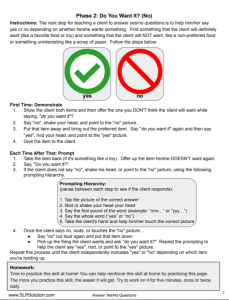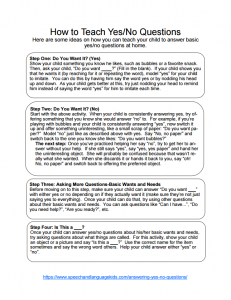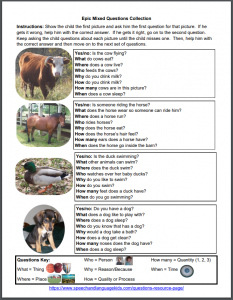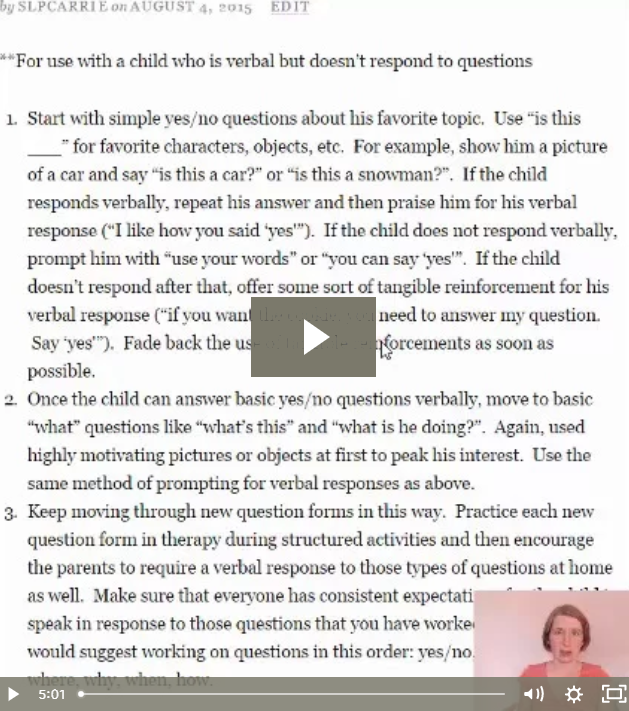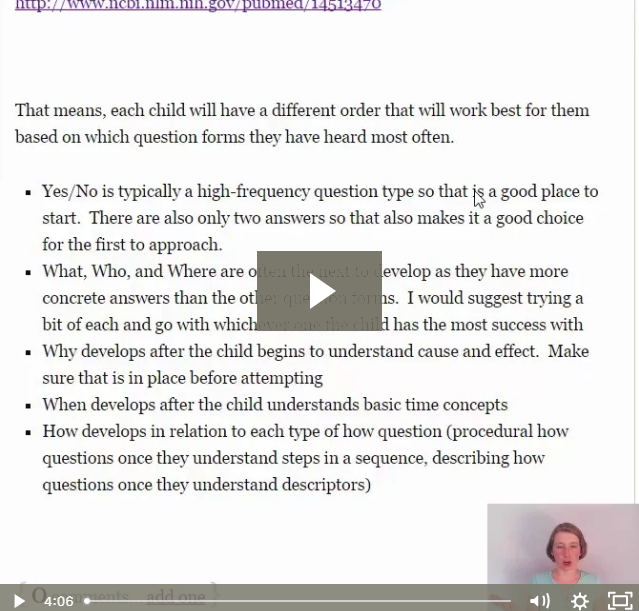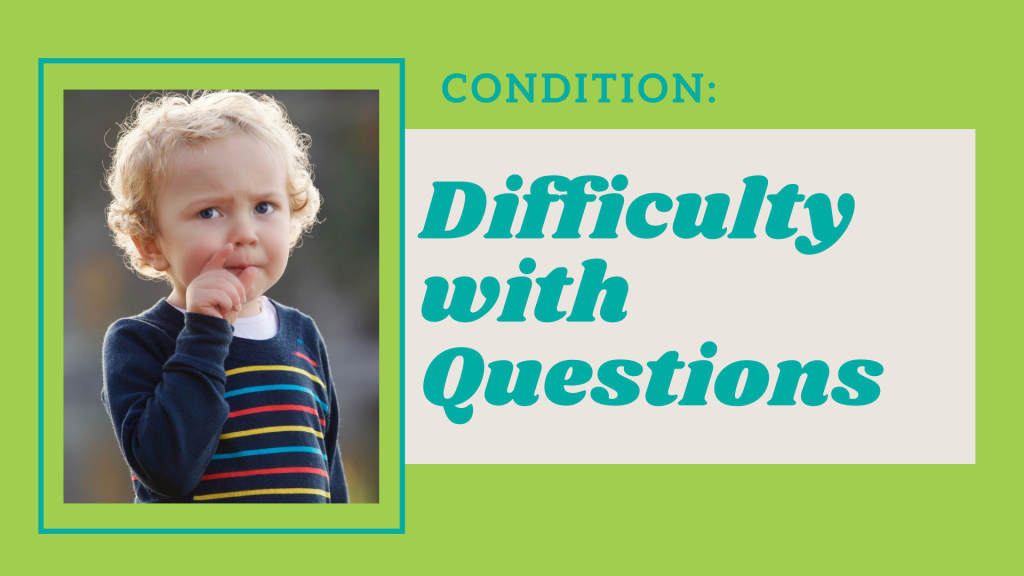Goal: Answer Yes/No Questions
Sample Goal:
During a structured therapy activity, Client will answer a variety of yes/no questions with at least 80% accuracy on 2 consecutive data collection days.
Download the No-Prep Therapy Kit:
We have a start-to-finish therapy kit that will give you everything you need to practice this skill in therapy and send home homework. Click the packet below to open it. Then, print it out and place it in the child’s notebook or binder.
Therapy Phases:
- Do You Want It? (Yes): Client will say/indicate “yes” in response to the yes/no question “do you want it” when presented with a desired object/action on at least 80% of observed opportunities.
- Do You Want It? (No): Client will say/indicate “yes” or “no” in response to the question “do you want it” to indicate a preference when presented with either a desired object/action or an undesired object/action on at least 80% of observed opportunities.
- Basic Wants and Needs Yes/No Questions: Client will say/indicate “yes” or “no” to answer basic yes/no questions about his/her wants and needs, such as “do you need help” and “are you ready” on at least 80% of observed opportunities.
- Identification Questions: Client will answer “yes” or “no” when asked “is this a ___” to identify the name of an object/item with at least 80% accuracy.
- Mixed Yes/No Questions: During a structured therapy activity, Client will answer a variety of yes/no questions with at least 80% accuracy on 2 consecutive data collection days.
Additional Information:
- If the Child Isn’t Speaking Yet: Yes/No Questions are a great place to start for children who aren’t speaking yet. Do all of the same activities as above but have the child nod or shake his head instead of speaking. You can also give him/her pictures that represent yes and no and have him point to the correct picture instead. Or, if he’s an AAC user, have him use the yes/no buttons on his AAC device or system.
- What’s Next? Once the client has mastered yes/no questions, you can move on to the next type of questions that he/she needs to practice. Click Here to view the other questions resources.
Supplemental Materials
Here are some other resources that may help you when working on this skill:
Yes/No Questions Handout
A written description of how to teach a child to answer yes/no questions. Perfect handout for sending home with families or educators.
Mixed Questions Pack
Several worksheets with pictures of common objects and questions for each one. Each picture has a yes/no question along with a variety of other question types.
Training Videos:
Need some extra help on treating this skill? Check out these related training videos:
More Activity Ideas:
Show the child something you know he likes, such as bubbles or a favorite snack.
Then, ask the child, “Do you want ____?” (Fill in the blank). If the child shows you that he wants it (by reaching for it or repeating the word), model “yes” for the child to imitate. You can do this by having him say the word yes or by nodding his head up and down. As the child gets better at this, try just nodding your head to remind him instead of saying the word “yes” for him to imitate each time.
Start with the above activity. When the child is consistently answering yes, try offering something that you know she would answer “no” to. For example, if you’re playing with bubbles and the child is consistently answering “yes”, now switch it up and offer something uninteresting, like a small scrap of paper: “Do you want paper?”
Model “no” just like as described above with yes. Say “No, no paper” and
switch back to the one you know she likes: “Do you want bubbles?”
The next step: Once you’ve practiced helping her say “no”, try to get her to answer without your help. If she still says “yes”, say “yes, yes paper” and hand her the uninteresting object. She will probably be confused because that wasn’t really what she wanted. When she discards it or hands it back to you, say “oh! No, no paper” and switch back to offering the preferred object.
Variation: If the child doesn’t seem to care one way or another about the undesired object and would be fine playing with that instead, you may have to find something a little more un-motivating. For example, if you want to elicit a good “no” out of me, you would offer me some styrofoam and a piece of cardboard. I HATE the sound that those two materials make when they rub together. Think about something that would get a good immediate “no” response from the child. Maybe it’s a food he doesn’t like or a toy that he’s not fond of. We don’t want to frighten or scar him for life or anything so don’t go with something he’s terrified of, but something unpleasant may be the way to go.
Before moving on to this step, make sure the child can answer “Do you want ___” with either yes or no depending on if they actually want it (make sure they’re not just saying yes to everything). Once the child can do that, try using other questions about their basic wants and needs. You can ask questions like “Can I have…”, “Do you need help?”, “Are you ready?”, etc.
Once the child can answer yes/no questions about his/her basic wants and needs, try asking questions about what things are called. For this activity, show the child an object or a picture and say “Is this a ___?” Use the correct name for the item sometimes and say the wrong word other times. Help the child answer either “yes” or
“no”. You can use simple visuals for yes and no and have the child point to the correct one while he says it.
Variation: Some of our clients aren’t great with vocabulary so this task may be too challenging. Instead, do an activity where you try something and say “no” every time it doesn’t work and “yes” when it finally does. I like to do this with those cut-out puzzles that have 5-6 pieces cut out of a board. Take one of the pieces and hold it up to the wrong spot. Say, “Does it fit? No.” Continue to say “no” each time you try to put it in the wrong spot. When it eventually works, say “yes!” and put it in. You can do this with other objects and activities as well. Take a hat and put it on various body parts while saying “no”. Then, put it on your head and say “yes”.

